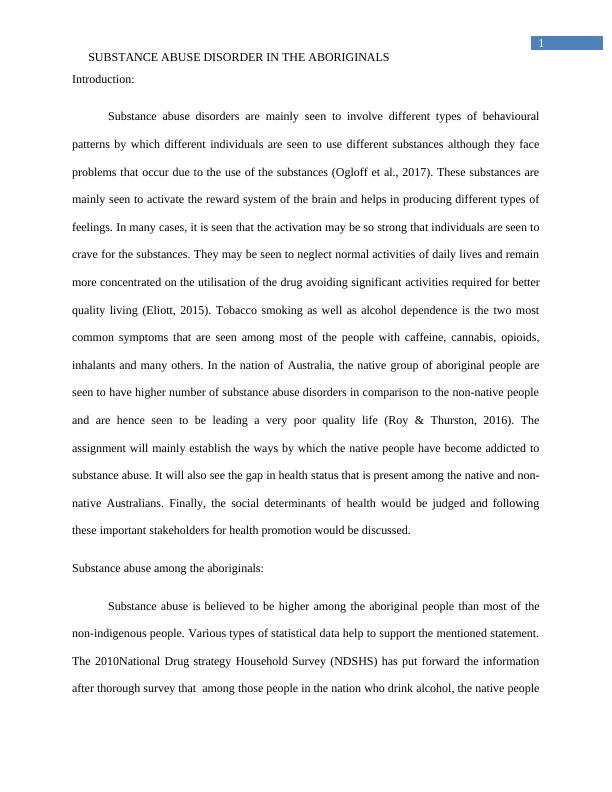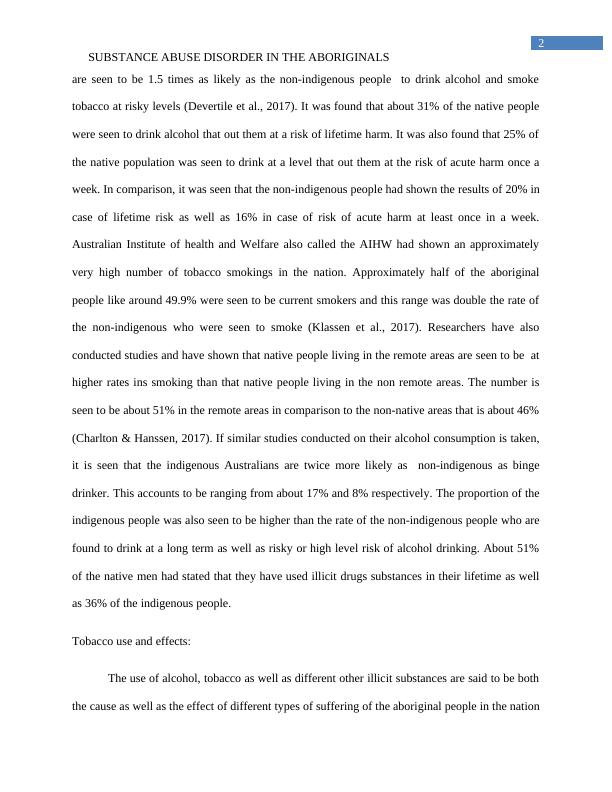Substance Abuse disorders in the Aboriginal - PDF
16 Pages4757 Words73 Views
Added on 2021-06-17
Substance Abuse disorders in the Aboriginal - PDF
Added on 2021-06-17
ShareRelated Documents
Running head: SUBSTANCE ABUSE DISORDER IN THE ABORIGINALSSUBSTANCE ABUSE DISORDER IN THE ABORIGINALSName of the student:Name of the individual:Author note:

1SUBSTANCE ABUSE DISORDER IN THE ABORIGINALSIntroduction:Substance abuse disorders are mainly seen to involve different types of behaviouralpatterns by which different individuals are seen to use different substances although they faceproblems that occur due to the use of the substances (Ogloff et al., 2017). These substances aremainly seen to activate the reward system of the brain and helps in producing different types offeelings. In many cases, it is seen that the activation may be so strong that individuals are seen tocrave for the substances. They may be seen to neglect normal activities of daily lives and remainmore concentrated on the utilisation of the drug avoiding significant activities required for betterquality living (Eliott, 2015). Tobacco smoking as well as alcohol dependence is the two mostcommon symptoms that are seen among most of the people with caffeine, cannabis, opioids,inhalants and many others. In the nation of Australia, the native group of aboriginal people areseen to have higher number of substance abuse disorders in comparison to the non-native peopleand are hence seen to be leading a very poor quality life (Roy & Thurston, 2016). Theassignment will mainly establish the ways by which the native people have become addicted tosubstance abuse. It will also see the gap in health status that is present among the native and non-native Australians. Finally, the social determinants of health would be judged and followingthese important stakeholders for health promotion would be discussed.Substance abuse among the aboriginals:Substance abuse is believed to be higher among the aboriginal people than most of thenon-indigenous people. Various types of statistical data help to support the mentioned statement.The 2010National Drug strategy Household Survey (NDSHS) has put forward the informationafter thorough survey that among those people in the nation who drink alcohol, the native people

2SUBSTANCE ABUSE DISORDER IN THE ABORIGINALSare seen to be 1.5 times as likely as the non-indigenous people to drink alcohol and smoketobacco at risky levels (Devertile et al., 2017). It was found that about 31% of the native peoplewere seen to drink alcohol that out them at a risk of lifetime harm. It was also found that 25% ofthe native population was seen to drink at a level that out them at the risk of acute harm once aweek. In comparison, it was seen that the non-indigenous people had shown the results of 20% incase of lifetime risk as well as 16% in case of risk of acute harm at least once in a week.Australian Institute of health and Welfare also called the AIHW had shown an approximatelyvery high number of tobacco smokings in the nation. Approximately half of the aboriginalpeople like around 49.9% were seen to be current smokers and this range was double the rate ofthe non-indigenous who were seen to smoke (Klassen et al., 2017). Researchers have alsoconducted studies and have shown that native people living in the remote areas are seen to be athigher rates ins smoking than that native people living in the non remote areas. The number isseen to be about 51% in the remote areas in comparison to the non-native areas that is about 46%(Charlton & Hanssen, 2017). If similar studies conducted on their alcohol consumption is taken,it is seen that the indigenous Australians are twice more likely as non-indigenous as bingedrinker. This accounts to be ranging from about 17% and 8% respectively. The proportion of theindigenous people was also seen to be higher than the rate of the non-indigenous people who arefound to drink at a long term as well as risky or high level risk of alcohol drinking. About 51%of the native men had stated that they have used illicit drugs substances in their lifetime as wellas 36% of the indigenous people. Tobacco use and effects:The use of alcohol, tobacco as well as different other illicit substances are said to be boththe cause as well as the effect of different types of suffering of the aboriginal people in the nation

3SUBSTANCE ABUSE DISORDER IN THE ABORIGINALSof the Australia. Such a disorder is seen to result in serious harm to the physical health of theindigenous people. They also result in poor social and psychological conditions of theaboriginals that altogether result them in living poor quality lives. Tobacco smoking is found tobe one of the most important risk factor that results in the development of heart as well ascirculatory system disorders. Such disorders are mainly seen to include different types ofcoronary heart diseases as well as stroke and different peripheral vascular diseases. Tobaccosmoking makes them also exposed to the numerous types of cancer and even respiratory diseasesand even different types of variety of other conditions (Scott et al., 2015). Not only has suchsmoking habited results the individuals to be highly affected but also affects the other people ofthe family members who live in close proximity with the smokers. It is mainly seen suchsmoking disorders mainly result in occurrence of asthma in the children of the native families.Moreover the family members are also seen to become vulnerable to different types lowerrespiratory tract infections along with the occurrence of the lung cancers and others coronaryheart diseases. Tobacco is seen to be highly associated with the socioeconomic status of thepeople and it is indeed seen from the researches that low socio-economic people are more likelyto smoke in comparison to that of the higher socio-economic status in a risky manner. Tobaccosmoke disorder is found to be associated with poor diet as well as long term or high risk drinking(Shahram et al., 2017). The health impact of the smoking is well evident from the higher rates ofthe hospitalisations as well as the deaths from the tobacco related conditions. In the nation of theAustralia, about two third of the deaths among the current smokers are mainly attributed to thesmoking and the current smokers are seen to face death an average of 10 years earlier than thenon smokers in the aboriginals. Thereby, tobacco is forum to be the leading contributor of theburden of the disease among the native Australians that accounts for about 12%. 23% of the gap

End of preview
Want to access all the pages? Upload your documents or become a member.
Related Documents
Health Promotion Programs - PDFlg...
|13
|3654
|238
Harm Minimization: Substance Abuse in Australialg...
|12
|2943
|244
Global Perspective of Healthcare - PDFlg...
|15
|4498
|75
Addressing SDH in Health Policy Rationalelg...
|20
|5221
|71
Critical Analysis of Substance Abuse Services in Australialg...
|11
|3346
|2
Alcohol Consumption among Aboriginals and Torres Strait Islanderslg...
|1
|1792
|281
